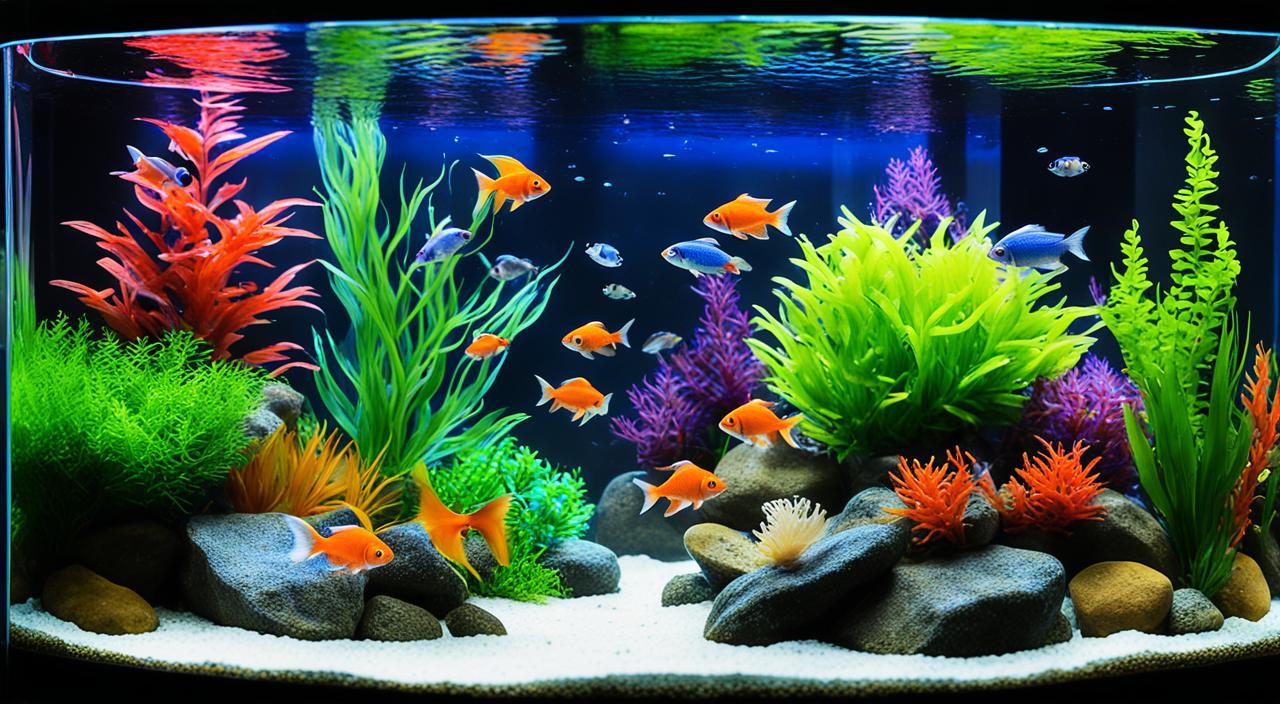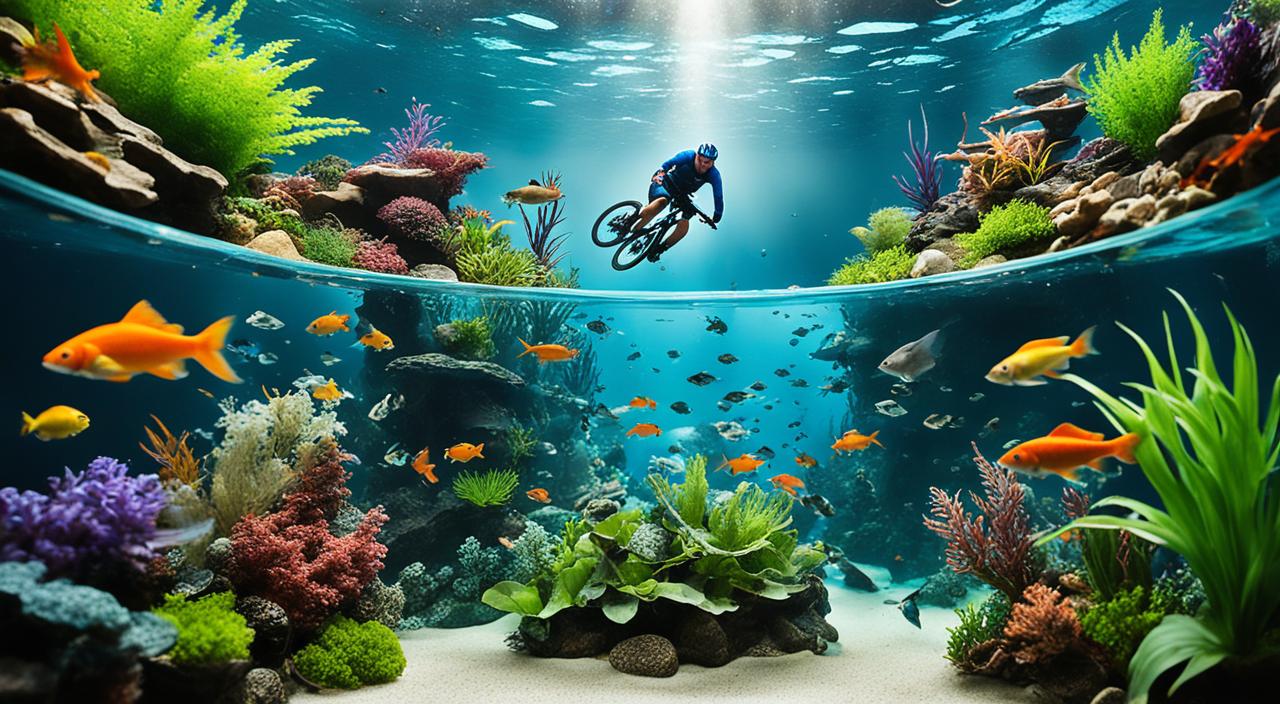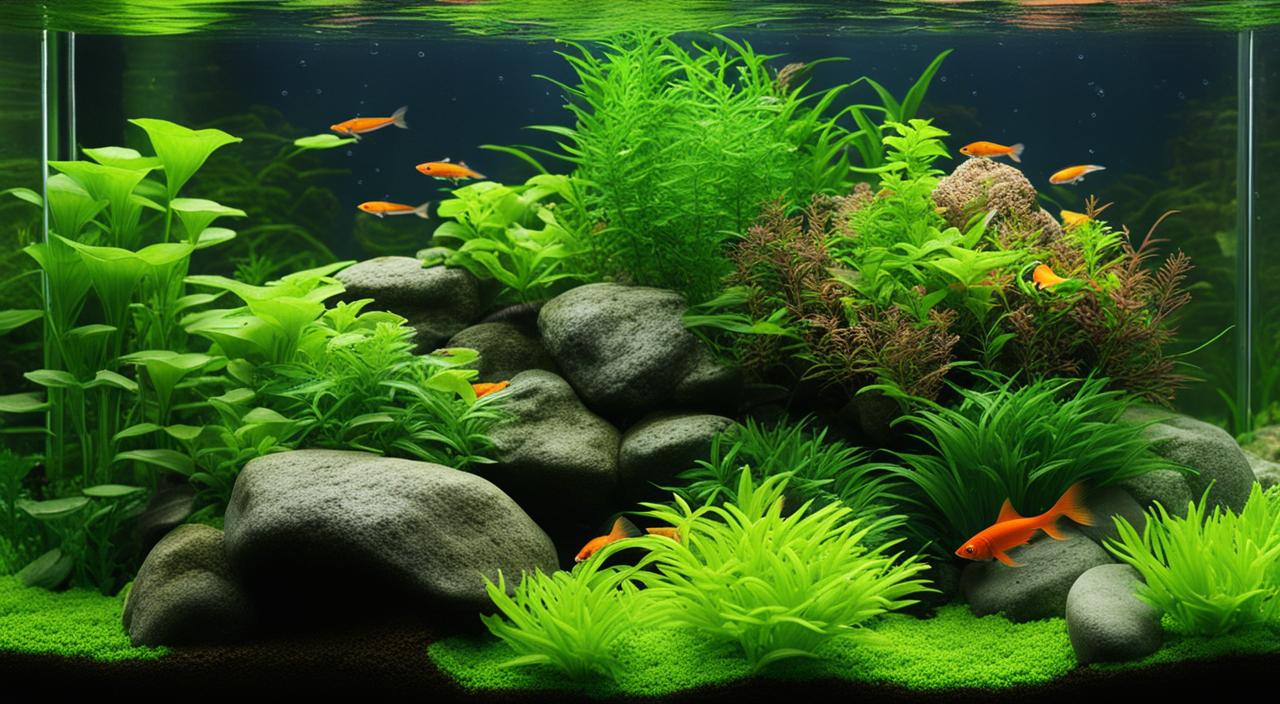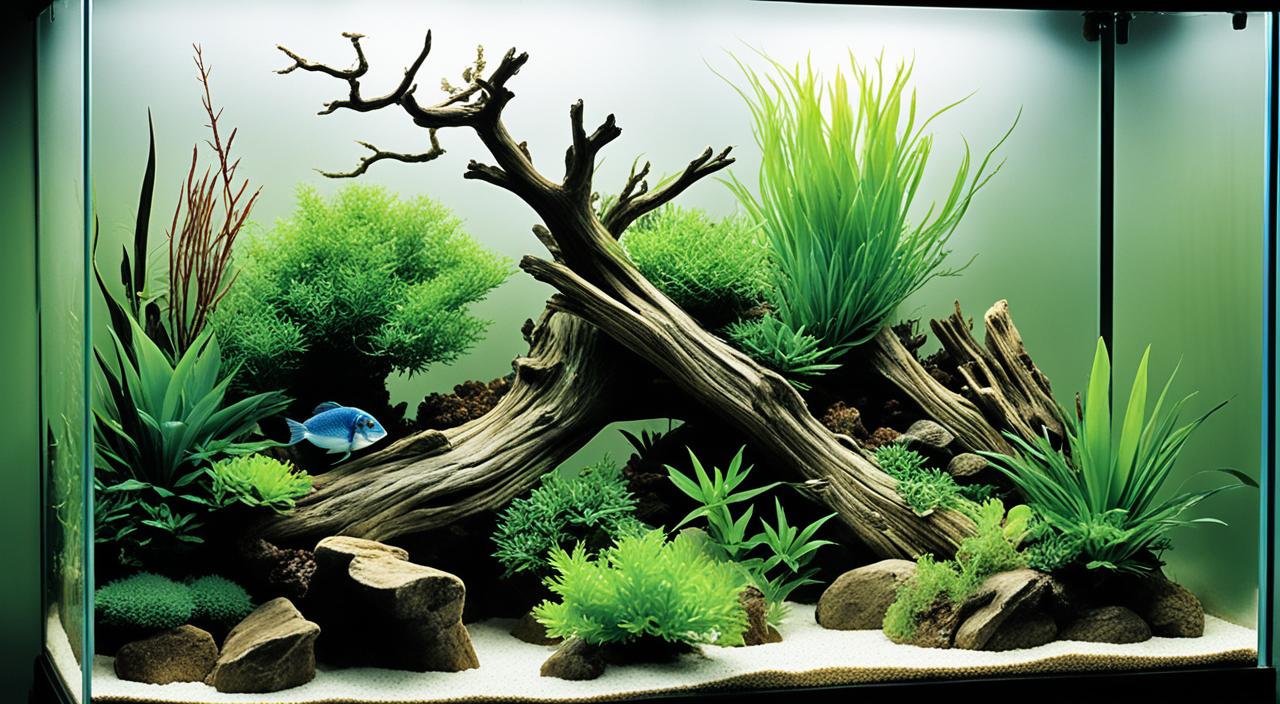The process of aquarium cycling can be frustrating and time-consuming. It typically takes weeks, or even months, for the tank to cycle and become safe for fish. However, there are effective methods to speed up the cycling process and reduce the waiting time. Following these tips and techniques can accelerate the cycling process and create a healthy habitat for your fish more quickly and efficiently.
Key Takeaways:
- Utilize time-saving cycling strategies to accelerate the aquarium cycling process.
- Implement quick cycling tips and fast-paced cycling methods to reduce waiting time.
- Focus on optimizing water quality as the foundation for efficient cycling
- Consider using beneficial bacteria from an established tank to jump-start the cycling process
- Explore the use of bacteria in a bottle to establish beneficial bacteria colonies more quickly
The Myth of the Instant Cycle
It is a common misconception that there are products or techniques available that can instantly cycle an aquarium. Some may claim to achieve an instant cycle, but this is unrealistic or unsafe for the fish.
Instant cycling methods often result in undetectable levels of harmful substances like ammonia and nitrites, which can be detrimental to the well-being of the fish. It is essential to understand that there is no shortcut to aquarium cycling, and patience is vital.
When it comes to fish tank cycling or aquarium cycling, there are no magic solutions or quick fixes. It is a process that requires time and the establishment of a stable nitrogen cycle. This cycle involves the growth and colonization of beneficial bacteria that convert toxic ammonia into less harmful substances, such as nitrites and nitrates. These bacteria need time to establish and reach sufficient numbers to process the waste the fish produces effectively.
Attempting to rush the cycling process can result in unstable water conditions and stress for the fish. Providing a safe and healthy environment for your aquatic pets is crucial. Following proper cycling methods and allowing the necessary time for the aquarium to stabilize will ensure the well-being of your fish and promote an optimal habitat for them to thrive.
Now that we understand the myth of the instant cycle let’s explore some effective methods to accelerate the aquarium cycling process without compromising the safety and health of our fish.
The Importance of Patience in Aquarium Cycling
Patience plays a vital role in the success of fish tank cycling. It can be tempting to seek shortcuts or quick solutions, but it is essential to resist these temptations. Rushing the cycling process can lead to imbalances in water parameters and harm the fish. A slow but steady approach is the key to establishing a healthy and thriving aquarium.
Now, let’s move on to the next section and discover some time-saving cycling strategies and tips to help us speed up the aquarium cycling process effectively and safely.
Focus on the Basics
It’s crucial to focus on the basics and implement effective cycling efficiency techniques to optimise bike speed and improve cycling performance. One fundamental aspect to consider is maintaining good water quality in your aquarium. By following these simple steps, you can ensure a faster cycling process and create an optimal environment for your fish.
1. pH Balance
Keeping the pH level above seven is essential for optimizing bacterial growth during the cycling process. Lower pH levels can slow down bacterial growth, prolonging the time it takes for the aquarium to cycle. Regularly monitor and adjust the pH level to maintain a suitable environment for the beneficial bacteria.
2. Filter Maintenance
Another key factor in optimizing bike speed is to keep your aquarium filter turned on at all times. The filter provides oxygen to the beneficial bacteria, allowing them to thrive and efficiently break down ammonia and nitrites. Regularly clean and replace filter media to ensure proper filtration and optimize the cycling process.
3. Water Conditioner
When adding tap water to your aquarium, using a water conditioner to remove harmful chemicals, such as chlorine and chloramines, is crucial. These chemicals can hinder bacterial growth and impact the cycling process. A high-quality water conditioner will neutralize these chemicals, creating a safe and conducive environment for the beneficial bacteria to thrive.
4. Temperature Control
Maintaining the ideal temperature range of 65 to 85 degrees Fahrenheit is essential for optimizing bacterial growth and bike speed. Lower temperatures can slow down bacterial growth, lengthening the cycling process. Use a reliable aquarium heater to maintain a consistent temperature and provide an optimal environment for the beneficial bacteria to colonize.
These basic techniques will enhance cycling efficiency and promote a faster and more effective aquarium cycling process. By optimizing water quality, pH balance, filter maintenance, and temperature control, you can expedite the formation of a stable nitrogen cycle in your aquarium, improving overall cycling performance.
Rob, an Old Tank
If you want to accelerate and maximize your cycling potential, consider robbing an old tank for beneficial bacteria. This simple technique involves taking filter media or gravel from a well-established and cycled aquarium and introducing it to your new tank. The beneficial bacteria residing in the filter media or gravel will jump-start the cycling process in your new tank, reducing the waiting time.
However, it’s crucial to exercise caution when transferring materials between tanks to avoid introducing harmful bacteria or pests. Take the necessary precautions to ensure a smooth transfer and prevent contamination. By leveraging the existing beneficial bacteria from an old tank, you can significantly speed up the cycling process and create a healthy habitat for your fish more efficiently.
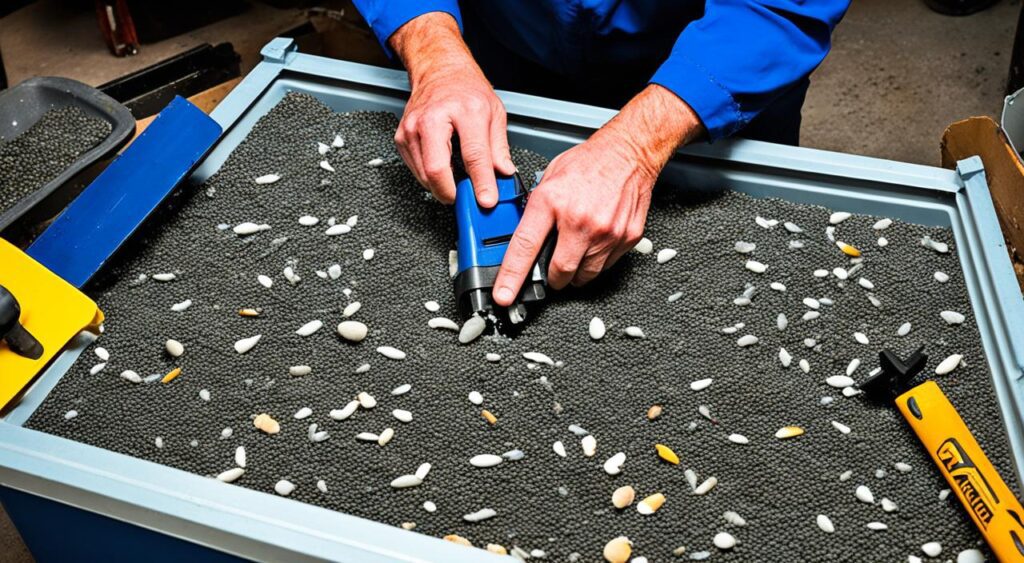
Use Bacteria in a Bottle
When maximizing the efficiency of the cycling process in your aquarium, using bacteria in a bottle can be a game-changer. These commercially available products are formulated with concentrated nitrifying bacteria that can help establish the essential bacterial colonies in the tank much more quickly.
Introducing these beneficial bacteria into the aquarium can accelerate the cycling process and create a stable environment for your fish in a shorter amount of time. However, choosing a reputable brand that offers high-quality bacteria products is crucial. Ensuring the viability of the bacteria in the bottle is vital for achieving optimal results.
When using bacteria in a bottle, it is essential to follow the instructions provided by the manufacturer. Each product may have specific guidelines for dosage and application. By adhering to these instructions, you can ensure that you are maximizing the potential of the bacteria and creating a healthy environment for your aquatic pets.
Remember that using bacteria in a bottle is just one technique in your arsenal of cycling efficiency techniques. It can be combined with other methods, such as using seeded filtration or introducing live plants, to accelerate the cycling process further and maximize your cycling potential.
| Pros of Using Bacteria in a Bottle | Cons of Using Bacteria in a Bottle |
|---|---|
|
|
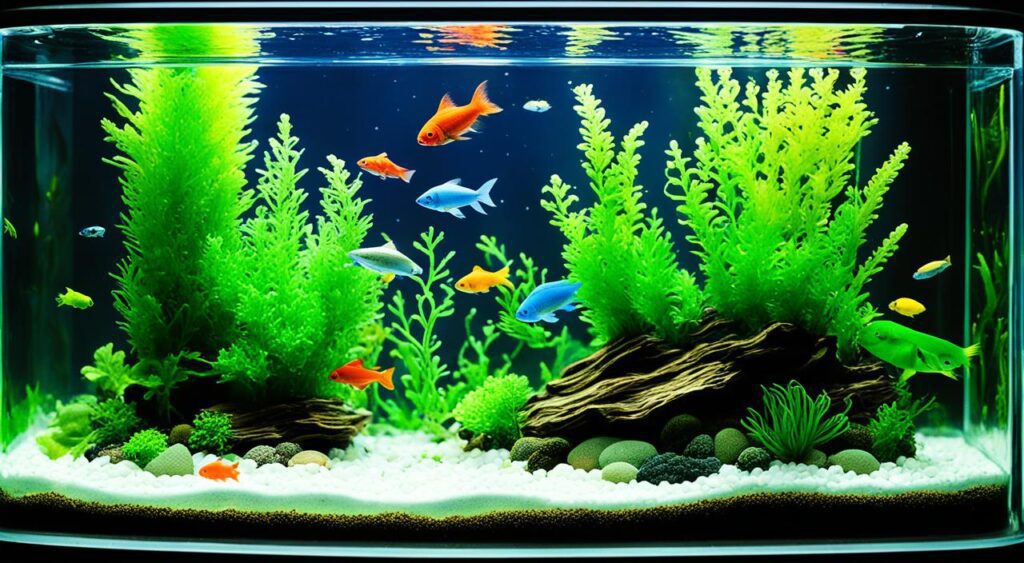
Expert Tip: Choose a High-Quality Product
When selecting a bacteria-in-a-bottle product, choosing a reputable brand known for its quality and effectiveness is crucial. Look for products that have positive reviews and recommendations from experienced aquarists.
Additionally, check the product’s expiration date to ensure that the bacteria are still viable. Expired or ineffective bacteria will not provide the desired results in accelerating the cycling process.
By choosing a high-quality bacteria-in-a-bottle product, you can maximize the efficiency of the cycling process and create a thriving aquarium for your fish.
Fish-In Cycling
Fish-in cycling is a popular method to speed up the aquarium cycling process while saving time. This fast-paced cycling strategy involves adding a few hardy fish to the tank during the cycling process. By introducing fish, their waste generates ammonia, which then stimulates the growth of beneficial bacteria in the tank. These bacteria convert ammonia into nitrites and nitrates, effectively kick-starting the cycling process.
While fish-in cycling can be a time-saving technique for improving cycling performance, it requires careful monitoring of water parameters and regular partial water changes. It’s crucial to keep ammonia and nitrite levels in check to ensure the well-being of the fish. Regular water testing using reliable water testing kits can help maintain optimal conditions for the fish and the beneficial bacteria.
When implementing fish-in cycling, choosing hardy fish species that can tolerate the cycling process is essential. Some commonly recommended fish for this method include Zebra Danios, White Cloud Mountain Minnows, and Rosy Barb. These species are known for their resilience and ability to adapt to fluctuating water conditions.
Gradually increasing the number of fish in the tank as the cycling progresses ensures that the biofilter can handle the waste produced. Adding too many fish at once can overload the beneficial bacteria and lead to fluctuations in water parameters, causing stress or harm to the fish. Patience and monitoring are essential throughout the fish-in cycling process to ensure a successful and efficient cycling outcome.
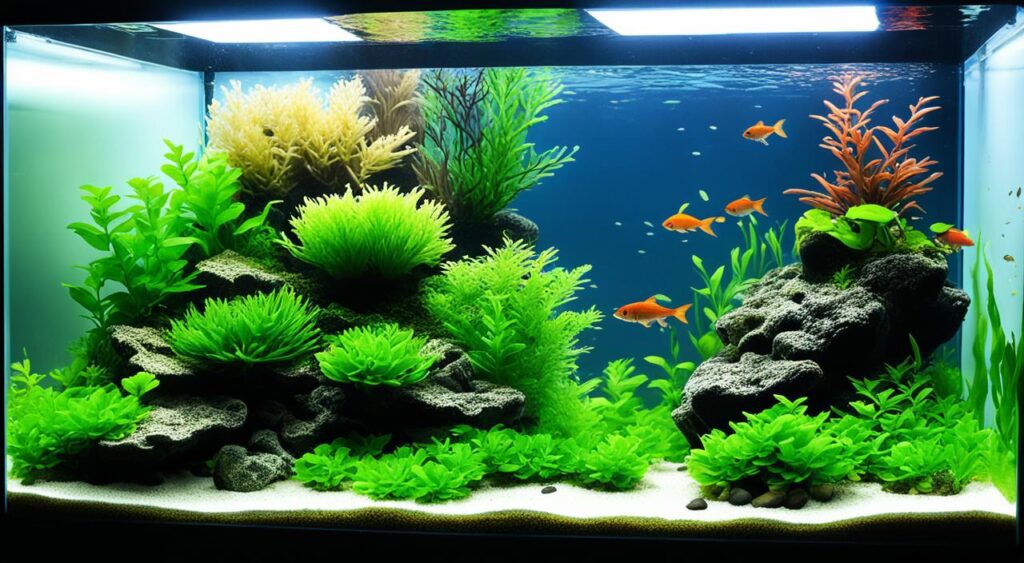
Cycling with Plants
Accelerating the cycling process of your aquarium can be achieved through the use of live plants. Not only does this method help establish a stable nitrogen cycle, but it also adds beauty and visual appeal to your tank. Live aquarium plants consume ammonia and nitrates, which are byproducts of fish waste, effectively reducing their levels in the water.
By introducing live plants from the beginning, you create a natural ecosystem that aids in the breakdown of fish waste, maximizing the cycling potential of your aquarium. To ensure the effectiveness of the plants in cycling the tank, it is essential to provide proper lighting, substrate, and fertilizers.
Benefits of Cycling with Plants
- Reduces ammonia and nitrate levels in the water, maintaining optimal water conditions for fish
- Enhances the visual appeal of the aquarium, creating a natural and aesthetically pleasing environment
- Promotes the growth of beneficial bacteria, establishing a stable nitrogen cycle more quickly
- Provides hiding places and shelter for fish, reducing stress and promoting overall well-being
When choosing plants for your aquarium, consider the specific requirements of each species. Some plants require higher light intensity, while others thrive in low-light conditions. It is essential to research and select plants that are suitable for your aquarium setup.
Here is an example of a table showcasing different types of aquarium plants and their specific lighting requirements:
| Plant Name | Lighting Requirement |
|---|---|
| Anubias Nana | Low to moderate light |
| Java Fern | Low to moderate light |
| Dwarf Hairgrass | High light |
| Vallisneria | Moderate to high light |
Remember to provide the appropriate substrate and fertilizers to support the growth of the plants. Substrate helps anchor the plants and provide nutrients, while fertilizers supplement the nutrients for vibrant growth.
Using Seeded Filtration
If you want to speed up the cycling process in your aquarium, using seeded filtration can be a game-changer. This method involves transferring a filter from an established tank onto the new tank, allowing the beneficial bacteria to colonize the filter and kickstart the cycling process.
When implementing seeded filtration, it is crucial to ensure that the water parameters of both tanks are similar. This will create a seamless transition for the bacteria, preventing stress or die-off. Additionally, it is essential to transfer the filter media quickly to maintain the bacterial colonies’ integrity.
Using seeded filtration can significantly reduce the cycling time in your new tank, giving you more time to enjoy your aquatic environment. However, remember that it requires careful maintenance and regular water quality monitoring to complete the cycling process.
FAQ
Can I instantly cycle my aquarium?
No, there is no shortcut to aquarium cycling. It typically takes weeks or months for the tank to cycle and become safe for fish.
How can I speed up the cycling process?
You can speed up the cycling process by maintaining good water quality, introducing beneficial bacteria from an established tank, using bacteria in a bottle, employing fish-in cycling, cycling with plants, and using seeded filtration.
What are the basics of maintaining good water quality?
To maintain good water quality, keep the pH above 7, keep the filter turned on at all times, use a water conditioner to remove harmful chemicals, and maintain the temperature between 65 to 85 degrees Fahrenheit.
How can I introduce beneficial bacteria from an established tank?
You can introduce beneficial bacteria by taking filter media or gravel from a cycled aquarium and adding it to the new tank.
What are bacteria in a bottle?
Bacteria in a bottle are commercially available products that contain concentrated nitrifying bacteria to help establish beneficial bacterial colonies more quickly in the aquarium.
What is fish-in cycling?
Fish-in cycling is a method where a few hardy fish are added to the aquarium during the cycling process to generate ammonia that can be converted by the beneficial bacteria in the tank.
How can cycling with plants accelerate the process?
Cycling with plants can accelerate the process by having live aquarium plants consume ammonia and nitrates, aiding in the breakdown of fish waste and establishing a stable nitrogen cycle.
What is seeded filtration?
Seeded filtration involves placing a filter from an established aquarium onto the new tank, allowing the beneficial bacteria from the established tank to colonize the filter and speed up the cycling process in the new tank.

